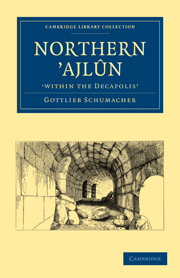Summary
THE KADA, OR PROVINCE OF IRBID, ITS NAMES, DIVISIONS, AND BOUNDARIES
The country described in the following Memoir covers an area of about 220 English square miles, and forms part, politically, of the great Kaimakâmiyeh, or Kada, of Irbid, one of the districts subordinate to the Liva (or Province) of Haurân. It is governed by a Kaimakâm, or Lieutenant- Governor, the subordinate Government Officials and the Mejlis el-Adâra, or Administrative Council, which last is chosen from among the most prominent Sheikhs of the villages in the district. A military force of some 40 mounted soldiers, “Khayyâleh el-Mîreh,” and some Zaptiyehs, or Police, are also at the disposal of the Kaimakâm.
The Kada of Irbid is bounded on the north by the Yarmûk River and the country of Jaulân; on the east in part by the Wâd esh-Shelaleh and the Haurân province, in part by the Syrian desert; on the south by the Wâd ez-Zerka and the Belka Province; and on the west by the Ghôr of the Jordan, forming part of the Government of Tabarîyeh (Tiberias Province).
The Kada of Irbid is subdivided into several districts called Nâhiyet (in the plural, in Arabic, called Nawâhy): and the following five Nâhiyets are for the most part included in the map of the country surveyed:—
Nâhiyet es-Siru,
Nâhiyet el-Kefarât,
Nâhiyet el-Wustîyeh,
Nâhiyet of the Beni Juhma,
Nâhiyet el-Kûra.
The southern half of the Kada of Irbid, lying between Tibneh and Kala't ʾAjlûn is called Jebel Ajlûn, and from it the Kada of Irbid is often spoken of as the Kada of ʾAjlûn, a name more often found in the descriptions of European travellers than heard in the mouths of the natives.
- Type
- Chapter
- Information
- Northern ’Ajlûn, 'within the Decapolis' , pp. 15 - 45Publisher: Cambridge University PressPrint publication year: 2010First published in: 1890

